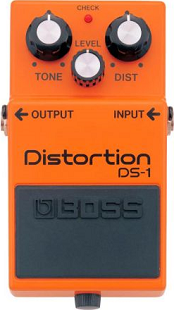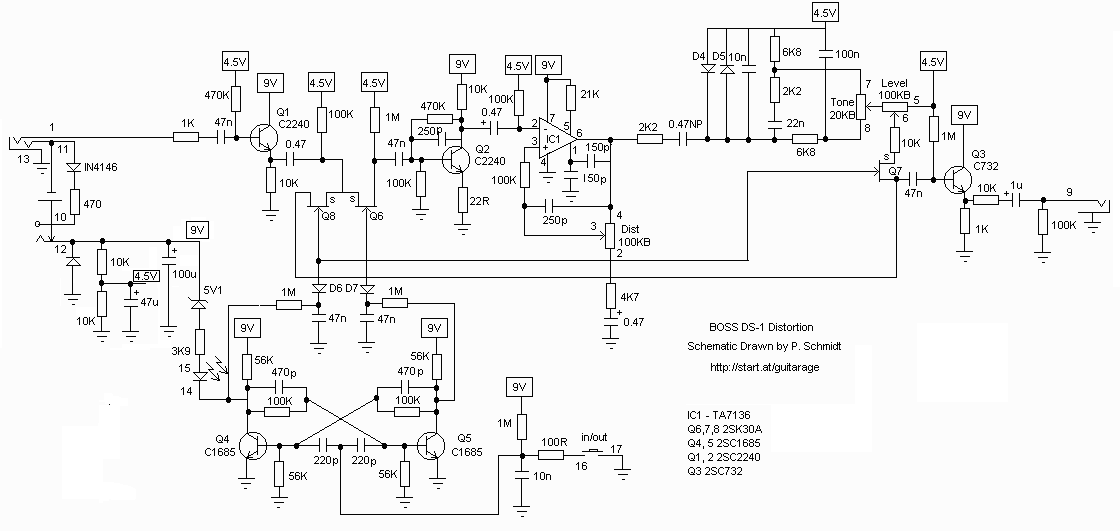Difference between revisions of "DS-1"
(→Post-Japan Mftg.) |
(→Phase Inversion: No) |
||
| Line 38: | Line 38: | ||
* [[Media:Boss_DS-1_OwnersManual1978.pdf|Boss DS-1 Distortion Pedal Owner's Manual circa 1978]] | * [[Media:Boss_DS-1_OwnersManual1978.pdf|Boss DS-1 Distortion Pedal Owner's Manual circa 1978]] | ||
| − | ==Phase Inversion: | + | ==Phase Inversion: IT DEPENDS!== |
===Distortion Circuit=== | ===Distortion Circuit=== | ||
Here we list the the active components in the order which the schematic indicates the instrument signal flows through them. Even if you're not familiar with reading a schematic, you should be able to see, at a basic level, how the instrument signal flows through the circuit. | Here we list the the active components in the order which the schematic indicates the instrument signal flows through them. Even if you're not familiar with reading a schematic, you should be able to see, at a basic level, how the instrument signal flows through the circuit. | ||
Revision as of 18:21, 1 July 2019
Boss DS-1 Distortion. Including the ProCo Rat, and the Electro Harmonix Big Muff Pi, this pedal has become renown for having earned the hearts of not only aspiring rock stars, but also for well-seasoned studio musicians and celebrity professionals.
The Boss DS-1 has gone through a couple of incarnations: the older and more highly-esteemed Made-in-Japan model, and the less-valued post-Japan model. Candidly, we don't really hear much of a difference, if any at all. After listening to a shoot-out between new and old models, many actually hear the newer DS-1 as "thicker" or "meatier" and like it better than the vintage model. We have a convenient link below for you to listen yourself.
We have an MIJ-version DS-1. Why do we have an MIJ DS-1? Not because we were on the look-out for one, but because one day we happened to see one at a Goodwill store. It was practically mint condition and the right price so we decided, "why not?"
- Thermionic Studios has one(1) Boss black-label (Made-in-Japan) DS-1 available for rental.
Controls

- Knob 1 - "Tone": Adjusts the Tone with fully clockwise allowing all the high-frequency tone information into the signal.
- Knob 2 - "Level": Adjusts the output level with fully clockwise full loudness.
- Knob 3 - "Dist": Adjusts the distortion level with fully clockwise being maximum distortion.
- Footswitch 1 - "On/Off": This footswitch toggles the pedal between engaged/active ("On"), and bypassed ("Off")
Bypass: Buffered
The DS-1, like all Boss pedals, has a fairly reasonable quality buffered bypass.
General Information
First offered for sale in 1978, the DS-1 Distortion was a follow-up to the Red-Yellow-Green pedal "marketing release" of the Boss SP-1 Spectrum (red), the OD-1 Overdrive (yellow), and the PH-1 Phaser (green).
Originally, the DS-1 was well received and today it continues to be a consistent, if much cheaper, seller for Boss. By contrast, none of the originally-conceived red-yellow-green pedals are even made or sold any longer. The SP-1 was killed off; and the OD-1 and PH-1 have been re-imagined into new pedals by Boss.
We have posted both versions of the schematics and the Owner's Manuals of the DS-1:
- The Made-in-Japan version
- The "Subsequent" version
Post-Japan Mftg.
Once Boss stopped making pedals in Japan and transitioned over to manufacturing in Taiwan, the architecture of the electronics changed. Most notably, a dual-opamp was used in place of the original single TA7136. Of course, other changes were made in resistors and capacitors in the effort to make the pedal sound the same. We think Boss did a pretty good job.
So, we're fairly agnostic with respect to the sound of a modern DS-1 as compared to a vintage DS-1. We don't hear much of a difference, if any at all. If we were forced to offer an opinion on which pedal sounds "better", in our estimation, we'd probably say that we think they sound the same, with perhaps the newer version sounding just a touch "thicker".
Pedal Manual
Phase Inversion: IT DEPENDS!
Distortion Circuit
Here we list the the active components in the order which the schematic indicates the instrument signal flows through them. Even if you're not familiar with reading a schematic, you should be able to see, at a basic level, how the instrument signal flows through the circuit.
| Schematic ID | Electronic Part | Action | Phase State |
|---|---|---|---|
| Q1 | 2SC2240 | Does not Invert | Original |
| Q6 | 2SK30A | Does not Invert | Original |
| Q2 | 2SC2240 | Inverts | Inverted |
| IC1 | TA7136 | Inverts | Reverted |
| Q3 | 2SC732 | Does not Invert | Reverted |
Switching
You'll probably notice that there are other active components in the schematic, but that we're not listing them. The reason being is that these components are part of the "clickless" switching portion of the pedal. They do not interact with any signal from an instrument, and therefore don't have a meaningful effect in terms of inverting the signal's phase.
Q4: 2SC1685, Q5: 2SC1685, Q7: 2SK30A, Q8: 2SK30A
Schematic
Artists
We are currently unaware of any artists actively using the pedal now, or who have in the past.
- Additional Sources
- https://www.diystompboxes.com/DIYFiles/up/Build_Your_Own_DS-1_Distortion.pdf
- https://www.youtube.com/watch?v=RhTxcfcT9fU - Listen for yourself to see if there's a big difference...
